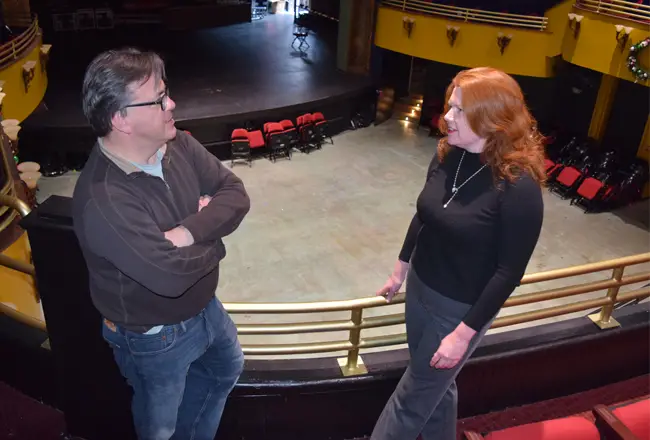
Suzanne Cahill was slightly apologetic in offering a tour of Norwalk”™s Wall Street Theater. “We just had a performance of ”˜The Nutcracker”™ and it”™s a bit messy,” she said as the janitorial crew cleaned the lobby.
Cahill, president of the nonprofit Wall Street Theater Co., was joined on the tour by Frank Farricker, president of Lockwood and Mead Real Estate in Greenwich and developer of the theater project. Together they worked to bring the long-vacant space back to life.
The Wall Street Theater began its life in 1915 as The Regent, a live-performance venue whose stage was graced by show business royalty, including John Barrymore, Lillian Gish and John Philip Sousa. The initials “TR” can still be seen at the peak of the theater”™s proscenium arch. Renamed the Norwalk Theatre in 1939, it was a movie theater until closing half a century later in 1989.
The theater, which is part of the Wall Street Historic District on the National Register of Historic Places, reopened in 1993 as a concert venue called The Marquee that presented bands, including Wu-Tang Clan and Living Colour. The Marquee closed a year after its opening, only to return in a few months under new ownership as The Globe, with musical acts that included David Lee Roth, The Go-Go”™s and Waylon Jennings. The property changed hands again in 1999 to become The Roxy dance club, but that incarnation only lasted one year.
The site remained closed to the public until May 15 this year, when the new Wall Street Theater had an opening gala featuring performances by Broadway singers that included Tony Award winner Betty Buckley and “Hamilton” star Mandy Gonzalez.
“This theater is important to various people of different ages,” said Farricker. “It”™s always been very important to Norwalk people. We see that all of the time and hear their stories. They come in here with their eyes open and can”™t believe it”™s back from the dead.”
But the resurrection of the theater was anything but quick and easy. The site at 71 Wall St. was initially a centerpiece of Norwalk”™s Wall Street redevelopment plan. But disagreements arose between the site”™s owners, Andrew D. Kydes and his wife Mary A. Kyriakides, and POKO Partners LLC, a Port Chester real estate development company that was brought in by the city to build a mixed-use retail and residential development in the surrounding neighborhood.
“It was carved out of the redevelopment because the owners at the time were not working in relationship with what the town”™s goals were,” said Cahill, who is also president of Red Mat Publishing in Milford.
Cahill and Farricker acquired the site for the nonprofit in January 2014 after two years of negotiations, financing the deal through a $1.5 million grant from the state, an $8.8 million loan from Patriot Bank and federal and state historic tax credits. Renovation began in September that year, but progress was halted by a delay in approval of a loan through the U.S. Department of Housing and Urban Development”™s (HUD) Section 108 loan guarantee program for economic development projects.
“We were looking to get a loan guarantee through Norwalk from HUD on a HUD 108 loan,” Farricker said. “But someone from HUD in Hartford called us and said it was illegal to do any construction until you”™re approved for the HUD loan, even though the HUD loan wouldn”™t have taken place until we were completed. It took HUD eight months to decide as to whether they”™d do the loan or not, so we had to shut construction down for eight months until they made up their mind.”
The total renovation work came to $10.5 million, Farricker said. In April, a Danbury contractor, The Morganti Group Inc., filed a mechanic”™s lien in court for nearly $1.5 million in allegedly unpaid work on the theater. The lien was increased to $2.4 million in May and is in arbitration.
Wall Street Theater in its latest incarnation can seat 690 people and has a 1,000-person standing room capacity. Using removable seats instead of floor-bolted seating enables different variations for the space, and Cahill noted that the theater is being sought out for corporate and nonprofit events.
“We can host anything from a Christmas party with a band playing to sales meetings,” she said. Rental fees are on a sliding scale and range from $4,500 to $13,000.
“We”™re a live-streaming facility,” said Cahill. “We have six positioned cameras and we can live-stream all over the world. Because of that, corporations can take advantage of our space, our sound and our lighting and can take their message to all of their corporate facilities. That”™s different from anything that”™s around here.”
Looking forward, Cahill is planning a youth-oriented musical theater program next year, along with a series of Broadway-level productions, dance events, stand-up comedy and karaoke happenings. “We”™re not going to be a straight concert house,” she said. “We”™re going to be an eclectic mix of things, especially with emerging artists and talent.”
Farricker added that the theater is working to become a self-reliant economic engine for this section of Norwalk. Other local businesses have expressed confidence in the theater”™s ability to attract people to the neighborhood, he said. “We built it without insisting that Norwalk give us stuff. Norwalk has been helpful and supportive, but we did get a standard construction loan,” said Farricker. “We paid for all of our permits. This is something we hope we can replicate in other communities.”
Cahill and Farricker are in negotiations with town officials in Stratford and Derby to acquire, renovate and reopen the long-closed American Shakespeare Theatre and the Sterling Opera House, respectively, in those communities.





















Comments 4